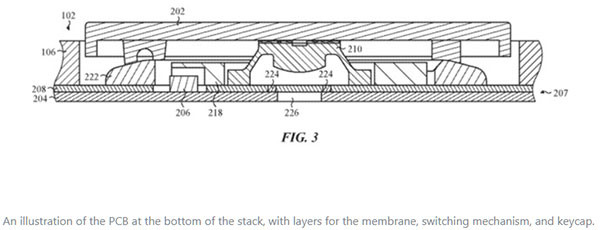It’s no secret that Apple has had problems with the keyboards used in recent MacBooks of all shapes and sizes. They’ve failed repeatedly at the slightest hint of debris, and now a new Apple patent shows different mechanisms that could lead to thinner notebooks.
The new patent, titled “Keyboard assemblies having reduced thickness and method of forming keyboard assemblies,” was published by the US Patent and Trademark Office earlier this week.

According to Apple Insider who spotted the patent, the mechanism will include a new single membrane that will be attached to the PCB itself.
In Apple’s filing, the company suggests the use of a single membrane sheet adhered directly to the printed circuit board (PCB). A switch housing can optionally be affixed directly to the membrane layer or to the PCB, sandwiched between the two, and a dome switch coupled directly on top to the membrane layer.
Generally the membrane is not typically attached to the PCB, but is used to help facilitate the closing of a connection, to trigger the key press. By attaching the membrane completely across the PCB, this eliminates any wasted space and brings the components closer together.

By moving the membrane it’s believed that replacing switches will be easier on the new keyboards, something that has proven troublesome with the current butterfly keyboards. With those, a failed key means an entire keyboard replacement which isn’t a small job on a modern Apple notebook.
Apple has been rumored to have a new keyboard in the works for months, and it certainly needs one. A new 16-inch MacBook Pro is said to be on the horizon and we’ll have our fingers crossed that one of these new keyboard mechanisms finds its way into the machine.
(Source: USPTO)
You may also like to check out:
- Downgrade iOS 13.1 Final To 12.4.1 / 13.0, Here’s How
- Best iPhone 11, 11 Pro Max Case With Slim, Wallet, Ultra-Thin Design? Here Are Our Top Picks [List]
- iPhone 11 / 11 Pro Max Screen Protector With Tempered Glass: Here Are The Best Ones
- iOS 13, iPadOS Compatibility For iPhone, iPad, iPod touch Devices
- How To Fix iOS 13 Problems, Crashing Apps Issue And Other Bugs
- Install WhatsApp Web On iPad Thanks To iOS 13 And iPadOS 13.1
- Jailbreak iOS 13 / 13.1 Status Update [Continuously Updated With Latest Info]
- iOS 13.1 Jailbreak Update: Security Content Fixes And Patches Detailed By Apple
- Download: iPadOS 13.1 Final IPSW Link, OTA Update For iPad Pro, iPad Air, iPad mini And More Released
- Download iOS 13.1 IPSW Links & Install On iPhone 11, Pro, XS, Max, XR, X, 8, 7, Plus, 6s, SE, iPod [Tutorial]
You can follow us on Twitter, or Instagram, and even like our Facebook page to keep yourself updated on all the latest from Microsoft, Google, Apple, and the Web.

